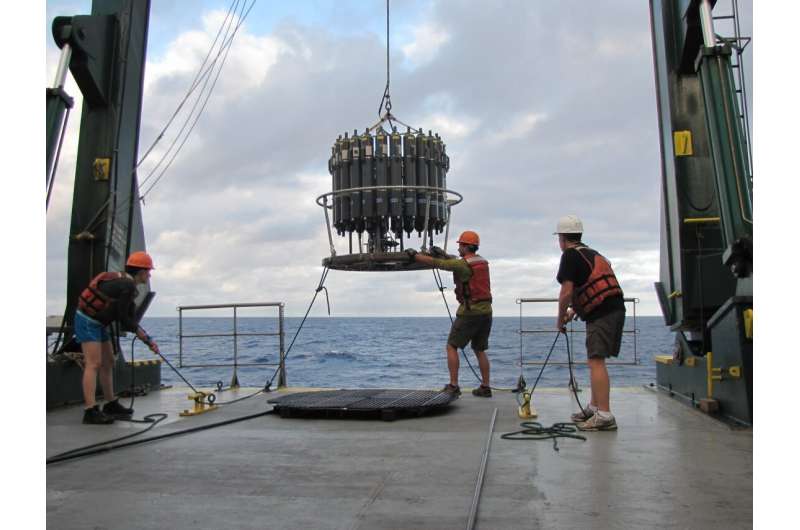Shift work helps marine microbes share scarce ocean resources

Though they may be small, microorganisms are the most abundant form of life in the ocean. Marine microbes are responsible for making roughly half of the organic carbon that's usable by life. Many marine microbes live near the surface, depending on energy from the sun for photosynthesis.
Yet between the low supply of and high competition for some key nutrients, like nitrogen, in the open ocean, scientists have puzzled over the vast diversity of microbial species found there. Researchers from the University of Washington, in collaboration with researchers from 12 other institutions, show that time of day is key, according to a study published Jan. 20 in Nature Ecology & Evolution.
The effort began in 2015, when scientists in the Simons Collaboration on Ocean Processes and Ecology, a program now co-led by UW oceanography professor Ginger Armbrust, looked at microbes in the surface of the North Pacific Subtropical Gyre, the Earth's largest stretch of contiguous ocean.
"[We were interested in] understanding how that fluctuation of photosynthesis during the day and the absence thereof at night propagates through the microbial community [in the ocean]," explained co-first author Angela Boysen, who did the work as a doctoral student at the UW and is now a postdoctoral researcher at the University of Chicago. "That influences how the ecosystem overall functions, how much carbon is stored, where the carbon moves around, and how organisms might interact with each other."
By integrating data on the timing of metabolic processes of different microbes in the surface ocean throughout the 24-hour light cycle—from the transcription of genes for proteins used in metabolism to the synthesis of molecules, like lipids, into the microbes' cells—the researchers discovered that the coexistence of such diverse microbes may not be dictated by competition, but by the timing of their nitrogen uptake.
With staggered uptake of the essential nutrient nitrogen, "instead of having to compete with the whole field, [microbes] only have to compete with the organisms that share that specific shift with [them]. Perhaps that's one way that the competition is slightly alleviated and can facilitate all of these diverse microbes being able to live off of the same nutrient source," said co-first author Daniel Muratore, a doctoral student at Georgia Tech.
Because of the interdisciplinary team present on the 2015 research cruise, data on almost the entire metabolic process was collected simultaneously from the same water every four hours, giving researchers an unprecedented look at how metabolic activity differs among these microbes throughout the 24-hour cycle.
"Collecting all these different sample types … at the same time is really a first way to look at the whole ecosystem all at once from all these different perspectives," Matthew Harke, a co-first author and research scientist at the Gloucester Marine Genomics Institute.
The data revealed that most of the activity occurred at four time points: dusk (6 p.m.), night (2 a.m.), morning (6 a.m.) and afternoon (between 10 a.m. and 2 p.m.). While these times were important for many types of microbes, different groups' activities at each time weren't uniform.
"Realizing that various types of microbes acquire nitrogen at different times of day helps to answer a long-standing question in oceanography: How can there be such an incredible diversity of life, all essentially in the same place at the same time?" said co-author Anitra Ingalls, a UW professor of oceanography. "Being able to explain the underlying reasons for this diversity will help oceanographers better predict how these communities may shift as the ocean changes."
Sacha Coesel, a UW research scientist in oceanography, is also a co-author.
More information: Daniel Muratore et al, Complex marine microbial communities partition metabolism of scarce resources over the diel cycle, Nature Ecology & Evolution (2022). DOI: 10.1038/s41559-021-01606-w
Journal information: Nature Ecology & Evolution
Provided by University of Washington




















